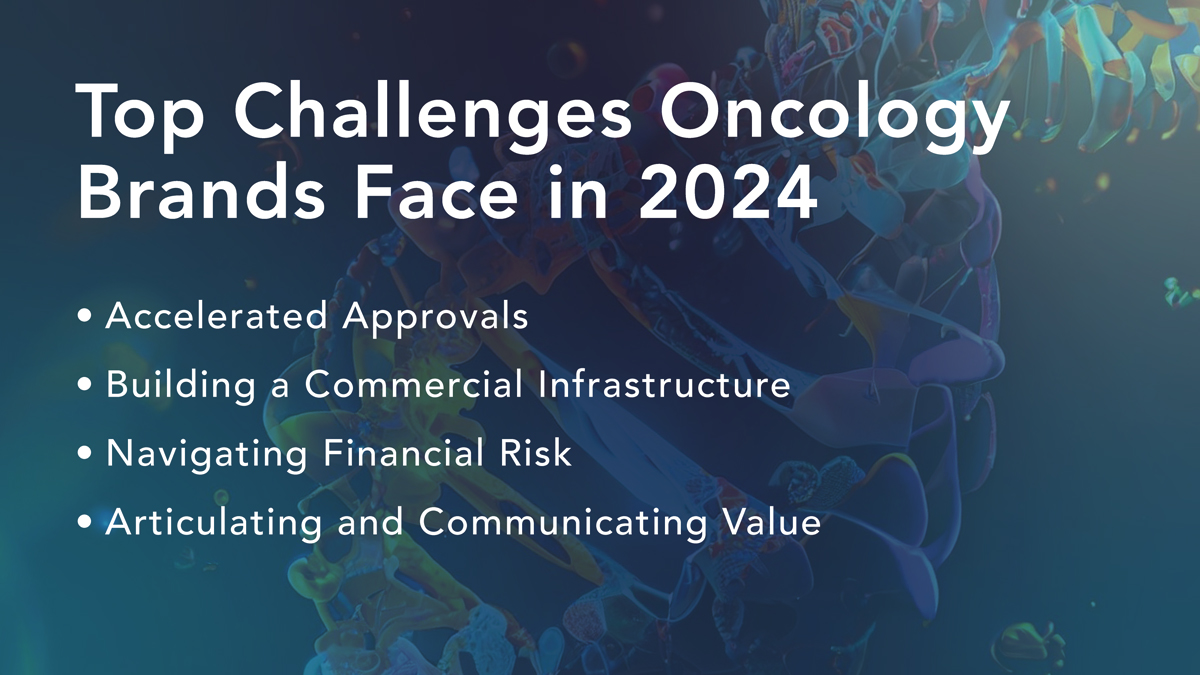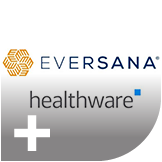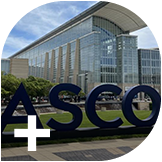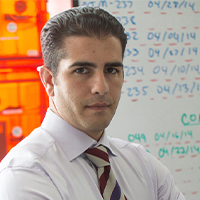Commercialisation in oncology: Challenges and innovative solutions for pharma manufacturers
Every day, manufacturers continue to develop new, life-saving cancer treatments, and breakthroughs in oncology promise to transform patient outcomes. Last month, the American Society of Clinical Oncology (ASCO) had its Annual Meeting in Chicago, highlighting groundbreaking advancements in cancer care and the rapid development of new drugs and therapies during the plenary session. Yet, behind these achievements, small and midsize manufacturers face a labyrinth of challenges that threaten to stall their progress.
Limited resources, a lack of expertise, and financial hurdles often impede drug manufacturers’ ability to navigate the complexities of bringing new therapies to market. As we look ahead to the second half of 2024, what obstacles must manufacturers overcome, and how can they navigate this complex landscape?
Anne Marie Robertson, executive vice president of EVERSANA Oncology Commercialisation, and Maneesh Gupta, senior partner at EVERSANA Consulting, offer their insights on the most pressing issues in oncology commercialisation and present solutions to help brands and patients alike.
What oncology brands are up against in 2024


Accelerated approvals: A double-edged sword
Anne Marie Robertson: The unmet needs in oncology, coupled with the biotechnology industry's development pipeline, create unprecedented pressure for rapid approvals. This urgency often results in more teams participating in the accelerated approval process.
The fast pace of drug development, while promising in terms of development timelines, often leads to substantial risk in launch planning. Brands are required to meet stringent regulatory requirements and ensure that their products demonstrate substantial clinical benefits to patients.
The need for accelerated approval often means that drugs are brought to market based on surrogate endpoints and require confirmatory trials. This approach, while beneficial for getting treatments to patients faster, creates significant challenges in recruiting the confirmatory trial and in meeting the clinical endpoints. The Food and Drug Omnibus Reform Act of 2022 requires that the confirmatory trial be underway at the time of approval and allows the Food and Drug Administration (FDA) to reject applications without confirmatory trials.
Maneesh Gupta: As of April 2023, 23 oncology drugs with accelerated approvals had withdrawn specific cancer indications, with 74% of these withdrawals occurring in the last three years. These withdrawals highlight the challenge of validating clinical benefits beyond surrogate endpoints through confirmatory trials.
Manufacturers must assess the unmet need in the disease area to justify seeking accelerated approval. Also, manufacturers have a hard time recruiting for the trials to meet the FDA timelines. Now, manufacturers can leverage integrated datasets, including longitudinal claims, EMRs, and prescriptions, to find hospitals and clinics that have the maximum number of potential patients who meet the inclusion and exclusion criteria.
Secondly, manufacturers that receive accelerated approvals do not need to shortchange their launch preparations or rush to out-license, fearing that the drugs will not be ready in time. They can leverage the prebuilt infrastructure of commercial partners that can bring these to market in less than a year while reducing the upfront costs of commercialisation by 25% or more.


Building a commercial infrastructure
Robertson: Drug developers often have no in-house expertise or physical infrastructure to build commercial operations and facilitate access to innovative solutions for supporting product commercialisation. The need to scale rapidly becomes paramount as a compound advances toward accelerated approval.
The transition from clinical development to commercial launch involves numerous growth challenges. Development-phase companies need to establish distribution networks, ensure compliance with regulatory requirements and build effective commercial teams. This phase demands a versatile infrastructure capable of adapting to the changing demands of the market. Development-phase companies need to create a value story for their development compounds prior to launch.
Gupta: Traditional third-party partners often lack the agility needed to navigate the complexities of the unpredictable oncology landscape. These models cannot be customised to address the unique needs of each partner, tumour type, and patient journey. Outsourcing efforts provide emerging companies access to expertise and resources they may lack internally.
Leveraging next-generation solutions such as omnichannel customer engagement platforms, electronic benefit verification (eBV), and direct-to-patient initiatives can optimise patient engagement and access. Commercialisation partners, which go beyond traditional service providers, can provide emerging companies with the same platform as large pharmaceutical manufacturers while adding the advantages of scalability, speed, and risk sharing.
Additionally, the integration of data analytics and artificial intelligence can significantly enhance the ability to predict physician behaviours and patient needs, thereby allowing for more informed decision-making. These technologies can help identify potential issues before they become significant problems, as well as raise promotional effectiveness significantly, enabling a proactive and precise approach to commercialisation.



Navigating financial risks
Robertson: Manufacturers grapple with the uncertainty of technical and regulatory success of FDA approval. Despite significant upfront investments, there is no assurance that products will reach the market. A new risk that must be considered is the potential for product withdrawal due to the results or accrual of the confirmatory trial.
A large biotech company recently received a complete response letter when the confirmatory trial was still in the safety phase at the time of product approval. We have also seen products withdrawn from the market and close the confirmatory trial, jeopardising years of research and corporate cash flow.
While large pharmaceutical companies may recalibrate and relaunch therapies, emerging and small manufacturers struggle with redesigning clinical plans and completing additional trials. Smaller manufacturers may find it more challenging to absorb the costs of additional trials and regulatory setbacks. These financial constraints can hinder innovation and delay the introduction of potentially life-saving therapies.
Gupta: By leveraging innovative solutions and strategic partnerships, manufacturers can mitigate financial risks. Access to expertise, resources, and advanced technologies help to navigate regulatory challenges and ensure a more efficient and successful commercialisation process.
Collaborating with third-party organisations that specialise in specific aspects of the commercialisation process can provide the necessary support without the need for significant capital investment. Also, these collaborations can enable manufacturers to scale up or down quickly and cost-efficiently.
The first five years of commercialisation typically cost upwards of $265 million. Manufacturers should not be forced to lose ownership, sacrifice their company value, or invest more than $200 million to commercialise on their own. Risk-sharing agreements and value-based pricing models are also emerging as viable strategies to manage financial risks.
These approaches align the incentives of manufacturers and commercialisation partners, ensuring that financial rewards are tied to partner success, clinical outcomes, and patient benefits.
Articulating and communicating value
Robertson: For first-to-market treatments, companies must raise awareness about how the therapy works and its benefits. Clearly articulating the value proposition allows the organisation to define and segment the landscape, negotiate pricing and reimbursement, and support a go-to-market strategy. This approach helps remove market access and affordability barriers, enabling patients to access the therapy quickly.
Effective communication strategies are essential to educate healthcare providers and patients about the benefits and potential risks of new therapies. This involves developing communication campaigns that reach all stakeholders, creating educational materials for patients and providers, and ensuring the community has a clear understanding of the benefits of the therapy as well as the best way to administer it to patients.


Gupta: Technological advances and personalised therapies driven by new tumour biology discoveries necessitate marketing efforts that can adapt to a changing landscape. Mapping diagnostic and treatment journeys through the unique lens of patient and provider archetypes is crucial. Without internal resources and financing, pharma innovators struggle to carry out concurrent planning and strategic development, which hinders successful commercialisation.
Leveraging omnichannel communications, including community-based digital platforms and social media, can enhance communication efforts, allowing for real-time interaction with healthcare providers and patients. These platforms provide an avenue for sharing the latest research findings, treatment protocols, and patient testimonials, thereby building trust and credibility in the market.
What's next?
The oncology market presents both significant opportunities and formidable challenges for pharma manufacturers. Robertson and Gupta's insights underscore the need for innovative solutions, strategic partnerships, and agile approaches to navigate the complexities of commercialisation. By leveraging expertise, advanced technologies, and customised strategies, manufacturers can overcome hurdles, optimise patient and provider engagement, and ensure the successful launch of lifesaving oncology therapies.
The future of oncology is bright, with continuous advancements promising improved patient outcomes and extended survival rates, including radiopharmaceuticals, cell and gene therapies, antibody drug conjugates, and biospecifics. However, realising this potential requires a concerted effort to address the multifaceted challenges of commercialisation. With the right strategies and support systems in place, manufacturers can navigate these challenges effectively, bringing new hope to patients battling cancer.
About the authors
Anne Marie Robertson
Executive vice president, EVERSANA Oncology Commercialisation
Anne Marie Robertson is helping EVERSANA deliver value to stakeholders across the life sciences industry. Through her multi-decade career at both large and small pharmaceutical companies, she has become a proven biopharma leader driving cross-functional teams. Specifically, she has a record of successfully commercialising oncology therapies, such as Erbitux, Inlyta, Onivyde, and Akynzeo, as well as developing new indications for in-market therapies. Her ability to set a launch strategy and create science-based differentiation allows her to leverage marketing strategies for clients globally while establishing and meeting launch metrics and driving overall brand value.
Robertson has an MBA from Baruch College of the City University of New York and a Bachelor of Science in Biology from Rensselaer Polytechnic Institute. Early in her career, she was a US Peace Corps volunteer in Central Africa.
Maneesh Gupta
Senior partner, EVERSANA Consulting
Maneesh Gupta is the practice lead for launch and complete commercialisation with the EVERSANA Consulting team. He is focused on helping clients and partners succeed at launches strategically, operationally, and financially by leveraging experience gained across more than 100 launches over the last 25 years.
Gupta comes to EVERSANA management consulting from IQVIA. He held a number of leadership roles over his 10 years at the firm, serving as practice lead, launch excellence and brand and commercial strategy. In this role, he led the practice in the United States, focusing on helping clients optimise their strategy, planning, implementation, and tracking. Among his many accomplishments, he conceptualised and developed IQVIA’s patient-centricity/patient journey offering and was recognised with an Outstanding Achievement of the Year award by IQVIA’s US president and honoured by a client with its Consulting Partner of the Year award.
Gupta holds an MBA in business administration from The University of North Carolina at Chapel Hill and an MBA in marketing and supply chain management from UNC Kenan-Flagler Business School. He earned his Bachelor of Chemical Engineering from Jadavpur University in Calcutta, India.
Supercharge your pharma insights: Sign up to pharmaphorum's newsletter for daily updates, weekly roundups, and in-depth analysis across all industry sectors.
Want to go deeper?
Continue your journey with these related reads from across pharmaphorum
Click on either of the images below for more articles from this edition of Deep Dive: Oncology 2024













